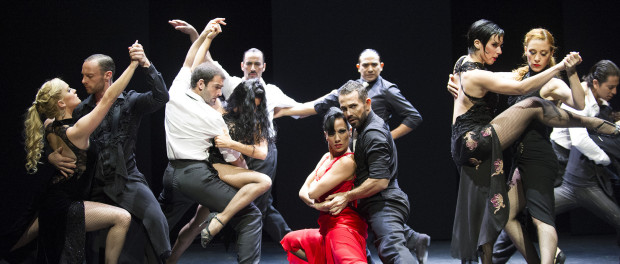Milonga: the eternal tango
 A scene from Milonga @ Theatre Jorat, Switzerland. Directed by Sidi Larbi Photo credit: Tristram Kenton
A scene from Milonga @ Theatre Jorat, Switzerland. Directed by Sidi Larbi Photo credit: Tristram Kenton
There’s nothing sexier than tango: the exposed thighs, the high heels, the strutting, the dipping, the embracing, the posturing. But there’s nothing less sexy than a cliché, than the use of technology and special effects for no discernable reason, and a show that goes on just a little too long.
In Milonga, presented by Danse Danse, Belgian-Moroccan choreographer Sidi Larbi Cherkaoui brings together ten international tango stars and two contemporary dancers to push the limits of the beloved Argentinian dance. And much of what he does is indeed fantastic. The dancers are obviously technically brilliant, and they radiate romance and passion. Dancing couples enact the steamiest of mating rituals, but Cherkaoui goes beyond that aspect of the genre and uses tango’s expressivity to explore the loneliness of an outsider, the heaviness of grief, the fast pace of the city, the fun of friendship, and even the humour of the clumsy and inelegant.
Some tableaux feature one or more couples, others feature soloists or trios (the male trios with their fancy footwork were the highlight of the evening for me), others feature crowd scenes, evoking the Argentinian milonga, where people gather in nightclubs to tango. The milonga effect was heightened by the use of projections, either onto a screen at the back of the stage, or onto moveable cutouts of people. Projections were used in other scenes as well, though not always successfully. The scene where individual dancers race frenziedly around the projected streets of Buenos Aires worked well. But the use of projections as a sort of touch screen, where a dancer moved images around, expanded and contracted them, didn’t make sense to me — it seemed to be technology for the sake of it, and had very little to do with the dance.
The live musicians added immeasurably to the event, both in terms of creating the atmosphere of a nightclub or dance hall, and in terms of simply providing great authentic live music, composed by Fernando Marzan and Szymon Bróska. Indeed I liked the play of authenticity, the intermingling of live music with choreographed dance but also with images of dancers, as if to say that each dancing couple embodies all the intrigue of every couple who ever lived, the courtship, the intimacy, the passion, the tenderness, the emotional violence, the fun, the frustration.
But I felt that despite Cherkaoui’s attempts to disrupt the genre, to push its limits and reverse its clichés, all while highlighting the dancers’ very impressive virtuosity, in the end it was a bit too much of a good thing — a bit too glossy, a bit too repetitive, a bit too smooth and polished and showy. That being said, the show received an instant standing ovation from the sold out audience, so obviously Cherkaoui spoke to the vast majority. But by the time one of the dancers started waving a white flag at the end, both my companion and I felt like giving up, like surrendering to the urge… to go home.






